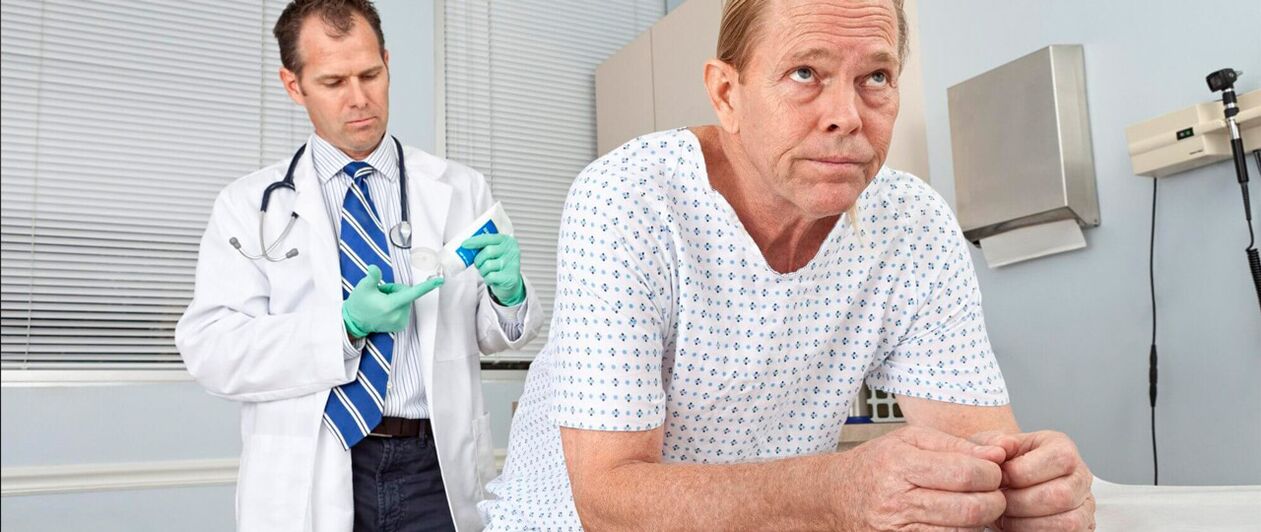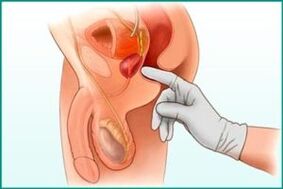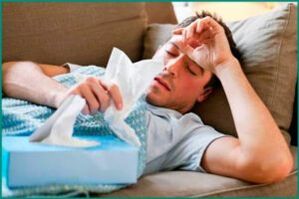
About half of the male patients visiting the urologist suffers from chronic prostatitis. Problems caused by a particular pathology exacerbate quality of life, leading to depression and mental disorders.However, a clear understanding of the mechanism of prostate gland and the development of inflammation allows us to correctly determine the symptoms and to cure the disease in time.
The meaning of the term "prostatitis"
This expression is customary to understand the formation of the inflammatory process in the tissues of the prostate.Because it is only present in the male body, the disease is common between this category of population.Its main function is to develop a particular liquid in the following processes:
- shapes and supports a certain environment in the urethra;
- dilutes sperm;
- ensures sperm viability;
- Protects the geniturinary system from infection.
As a result of many factors, secret secretion slows down, which in itself becomes a violation.Prostate epithelial cells are regularly deserved, but due to congestion they do not excrete, but accumulate and form micropics - small pebbles.The mucous membrane clogs the glandular ducts and leads to small abscesses.During this period, the body continues to function normally and the external negative manifestations are missing.
Progression of the process (accumulation of dense formations, increased concentration of purulent content) leads to compression of the urethra, blood vessels, blood vessels and nerve endings.This is one of the causes of the disease.
Symptoms of the disease based on the patient's complaints
Already in the section described above, the first signs are manifested, which one only notices.Based on these changes, it can identify the development of home inflammation regardless of the development of home.Of course, such a diagnosis is indicative, but it is considered a serious reason as a specialist in contact.
You -Diagnosis at home
What are the first signs of prostatitis in men?
Heavy outflow of urine.The compression of the urethral canal with the tissues of the prostate has increased the narrowing and, as a result, leads to preventing urine outflow.The patient should apply certain efforts during urination.
Remote emissions of urine.Calls for bladder emptying are becoming more common.At first this happens at night, later during the day.An extra cup of tea views one will continue to ignore the infringements.
Pain in the lower abdomen.The symptom is the result of the accumulation of micropolitics.Feelings become unpleasant and are painfully crushed, pulled or exploded.In the evening or after physical effort, their growth may occur.
Violation of erection and ejaculation.The syndrome occurs in the background of stagnant phenomena and is rarely displayed.Leading this to fatigue and stress, the patient also ignores this signal.
The patient often complains of the general deterioration of the condition and the increase in body temperature, which is also a sign of the developing process.
The first signs of prostatitis require treatment for men, otherwise the process will be prolonged.
Symptoms of acute inflammation
The misleading of prostatitis lies in the fact that initially, without characteristic manifestations, it begins to develop sharp and rapidly, but will quickly chronic.

In order not to miss the moment and start treatment in time, the symptoms of acute form require a clear idea of the symptoms.
- Fever, chills.
- The increase in body temperature into critical values (39 ° C).
- Severe pain in the perineum, lumbar and inguinal region.
- Urine disorders - frequent and false urgency, heavy outflow or temporary stopping of urine.
- Pressed intoxication - headache, weakness, pain in the joints and muscles, tachicardia.
- Transparent or whitish discharge from the urethra.
The rectum test becomes impossible due to the formation of pain syndrome.In fact, it is contraindicated because the spread (spread) (spread) of infection with blood flow and sepsis can be spread.
Manifestations of chronic relapse
Slowly, the pathological process of various types of diseases can occur.However, according to complaints from patients and diagnostic data, experts distinguish between chronic general prostatitis:
- Discomfort, moderate pain in the legs, sacrum, lower back, scrotum, weakness and pain.
- Severity and rubber in the urethra during intercourse or urination.The presence of round-looking emptying from the urethra.
- Frequent urination, feeling of incomplete emptying at the end of the process.
- Inability to fertilize sperm mobility, agglutination, or an increase in the acidity of the secrecy.
- Violation of ejaculation (early or vice versa, prolonged), pain or orgasm -deleted feelings.

Types of disease and simultaneous signs
Urologists distinguish between several stages of chronic inflammation of the gland, each of which corresponds to certain manifestations.
All species are characterized by a medium pain syndrome of pelvic floor.
| The form of prostatitis | Symptoms |
|---|---|
| Chronic bacterium | Dysuria, early ejaculation |
| Pedal pain syndrome | Lack of other manifestations, except for pain |
| Inflammatory | Expressed problems with urination, genitals discomfort |
| Stagnant | In some cases, dysuria, the inconvenience |
| Asymptomatic | There are no clinical manifestations |
Professional diagnostics
The doctor can already determine the presence of prostate inflammation during the first visit of a person.However, etiology, stage and complexity can only be determined through instrumental and laboratory research.
A primary examination of the doctor
History of anamnesis is an important stage of diagnosis of the patient and analysis of external symptoms.During the conversation, the doctor determines the presence of clinical symptoms and the cause of the pathological process.Here, the patient's lifestyle, bad habits, use of contraceptive methods and the presence of a sexual partner are important.At the same time, it draws attention to the likelihood of existing diseases of close relatives and the hereditary predisposition.
The next step is the rectal examination of the prostate gland. The palpation is done to determine such parameters:
The palpation is done to determine such parameters:
- the size of the organ;
- structure and outlines;
- presence of seals;
- pain.
Laboratory tests
The next step is to perform analysis.This category is quite extensive, so only one urologist determines each need.
OAM khrateusterizes the general condition of the urinary tract. Increased content of red blood cells, leukocytes and protein, as well as the presence of mucous membranes and other impurities indicate an extensive process of the inflammatory process.
The urethral smear is a painful and unpleasant procedure, which, however, allows the presence of the infection and to determine its variety.
The bacteriological sowing of the urine allows the localization of the lesion, the various infection and the type of pathogen.
The cytological analysis of the seed -fluid is performed to determine its physical -chemical properties, mobility, activity and concentration, and dog levels.The biological material is carried out immediately after the prostate massage in the laboratory.
The condition of the procedure is sexual abstinence during the day.In the event of a suspicion of chronic processing, this type of research is systematically carried out.
Symptoms perceived by instrumental diagnostic methods
Hardware methods are considered to be the most effective, which is due to accurate and detailed information on the physical characteristics of the prostate and the alleged pathological changes in the tissues.The doctors' work was greatly facilitated.
The entire species of species is usually performed only ultrasound and other methods are used if further results have to be achieved.
Ultrasound is performed to display the gland and determine its general condition, size and consistency.The transrectal method is considered more informative - Truzi.A special sensor is introduced into the rectum, which allows you to determine the appearance of the organ, to determine the tumors, adhesions, calculations, calcinates, cystic formations and other abnormalities.
MRI is prescribed to determine the type of prostatitis and to determine deeply clarification of previous results, especially if some details are still unclear.
Urofloometry determines the rate of urine flow, the time to reach maximum value, and the amount of urine.Performed with a special device.
Cistoscopy with a thin probe allows you to assess the condition of the bladder and urethral channel and to identify alleged and existing pathological changes.
The biopsy is performed in case of suspected oncological nature of the disease to exclude it.
Dangers of asymptomatic age of the disease
Prostatitis, which has no symptom, develops in patients with older age.

Reasons for its appearance:
- frequent hypothermia;
- constipation and hypodynamia;
- weakened immunity;
- a decrease in sexual activity;
- The presence of chronic pathologies.
Provocative factors are as follows:
- The age of a man;
- reduction of hormone production;
- To weaken prostate protective functions
- Degenerative processes in the tissue.
Due to the impossibility of timely detection of the disease, the lack of treatment involves the occurrence of such consequences:
- Persistent erection dysfunction;
- prostate tissue fibrosis;
- development of kidney and liver insufficiency;
- urolithiasis;
- Prostate, adenoma, cancer are benign hyperplasia.
Finding early doctor: complications
The risk of prostatitis lies in the rapid transition of chronic form with greased symptoms and in the absence of a clinical picture as an acute course.
This form cannot determine for a long time, leading to irreversible processes in the glandular tissues and various complications:
- Vesiculite, back urethra;
- prostate abscess;
- Obstruction of the glandular tissue sclerosis and eryrphic channels;
- polycystic formations;
- development of a mesh form;
- impotence and infertility, problems of conception;
- Urine pathologies - cystitis, pyelonephritis, urolithiasis;
- Nerve psychogenic disorders-apathy, prolonged depression, decrease in self-esteem.
Ways to alleviate the patient's condition
The characteristics of the choice of therapeutic tactics depend on the type of disease, the form of origin and the properties of leakage.
Asymptomatic treatment
The acute manifestation of the disease is extremely painful for the patient.Therefore, the priority task is to eliminate them.For this, medicine treatment is used.In the case of prostatitis, drugs are prescribed for men, depending on severe symptoms:
- Antibacterial drugs to eliminate the pathogen.
- Diuretics are drugs that stabilize bladder work to improve urine outflow.
- Analgesics - eliminating the pain of the head, joints and muscles.
- Malispasmodes and Alfa-1-Sima-Sima muscles.
The effective dosage form is considered to be suppositories.Candles are used to relieve acute symptoms:
- An antibiotic that eliminates painful cramps and struggles with infectious manifestations.
- With NSAIDs, compensating for inflammatory processes.
- With analgesic analgesic that improve the microcirculation of the blood and restore the normal prostate.
Eliminating the cause of inflammation
After stopping acute symptoms, the therapy of the main manifestations should be started.Treatment in this case is to eliminate infection and restore blood circulation.The following groups of drugs are used for these purposes:
- antibiotics in tablets;
- anti -inflammatory drugs;
- immunomodulators;
- Phytoprecreations.
If acute manifestations are absent but signs of prostatitis in men, the patient remains treated with physiotherapy, traditional medicine (pumpkin seeds, ginger and other drugs), alternative methods (leeches, bees bakers, hand therapy).Positive results are often achieved only after proper performance improvement.
Symptoms of primary prostatitis and aggravation of chronic form
Modern medicine successfully cope with eliminating prostatitis, even though long treatment.
For men who have passed an acute form or barely healed from chronic current, it is important to follow preventive measures:
- Life change is a change:
- regular walks;
- active sport;
- Denying bad habits.
- To restore normal sexual behavior:
- choosing a reliable partner;
- Rejecting random relationships;
- regular sexual relationships;
- Protected sexual intercourse.
- To follow the diet:
- Rejection of fatty, fried, spicy foods;
- The use of healthy and natural products.
- Preventive examination by a doctor:
- Regular - once every six months - tests;
- the transfer of the course of support therapy;
- Performing gymnastic exercises.
In the case of modern lifestyles, inflammation of the prostate gland is not a sentence.Despite its current severity and complexity, the various clinical species, the disease can be perfectly treated.However, in order to avoid the development of dangerous consequences and serious complications, we need to contact professionals in time.And to do this, you need to know all the features of the symptoms and symptoms of prostatitis.























